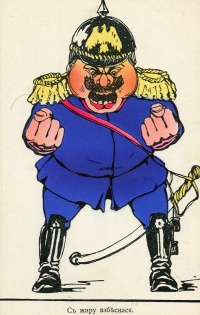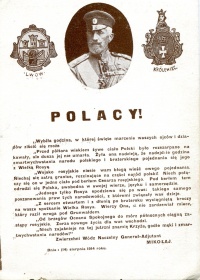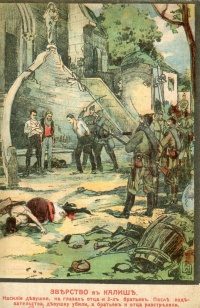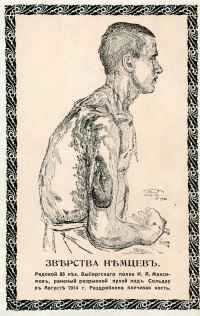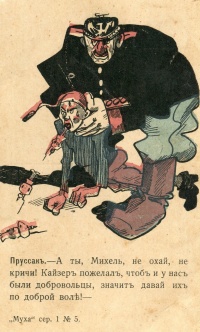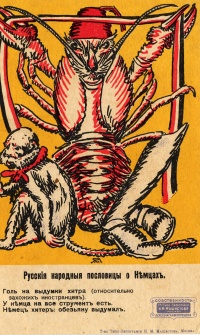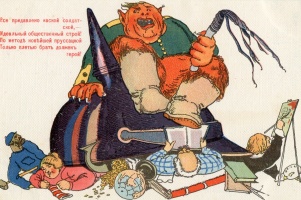Introduction↑
With all the exceptional importance and the new role of propaganda during the war years, its Russian version remains little studied. This reflects the general state of research on the "forgotten front" of the First World War. Moreover, in Russia the World War was, on the one hand, forced out of the collective memory by the events of the 1917 Revolutions and the Civil War and, on the other, ideologically reduced to the role of just one of the factors of the seizure of power in 1917 by the Bolsheviks. In the last decade and a half various aspects of Russia's participation in the war have drawn more attention from historians; however, with the rare exception, propaganda is touched on indirectly. The goal of the article is the study of the organization, content, means, and functions of propaganda in Russia during the war years.
The Organization and Means of Propaganda↑
The premises and conditions of the functioning of propaganda in Russia↑
The Russian public, which was to be motivated to fight, and to be shown its reasons, goals, and meaning, was the main target of propaganda. By the start of the war it had preserved a traditional nature in many respects, splitting into a multitude of relatively isolated worlds - social, national, religious, and cultural. The public sphere was quite narrow, mass culture was only making the first steps, remaining predominantly an urban phenomenon. Reading as the main instrument of reporting political content had substantially less scope in Russia than in the West. In 1913 the number of literate people was about 40 percent of the population.[1] The press had developed rapidly since the turn of the century; however, the daily circulation of newspapers in 1913 provided only twenty-one copies per 1,000 people.
Besides the insufficient development of channels of public communication difficulties arose with values to which propaganda ought to appeal. The lack of development of the political sphere and also the multi-ethnic composition of the population hindered the development of a modern understanding of patriotism and nationalism, but the traditional political orientations lost attractiveness. The statement of writer Aleksei Tolstoi (1882-1945) conveys the diffusion of patriotic positions even in the educational medium, "None of us, I think, sufficiently understood our attitude toward Russia; we did not even know whether we loved our country or just lived in it."[2]
The peasants, who composed the majority of the population, often had a quite confused idea of the "fatherland". As demonstrated by the famous Russian military leader Aleksei Brusilov (1853-1926), "The soldier not only did not know what Germany was, let alone Austria, but he had no concept of his own Mother Russia...Where was patriotism to come from here, a conscious love for a great homeland!"[3]
The degree of maturity of the Russian national identity remains an object of dispute in historiography; however, it is obvious that its development has lagged far behind the situation in France or Germany, for example, where nationalism itself became a very important interpreting and mobilizing factor. In Russia the capabilities of propaganda for an appeal to national sentiment were limited to the poorly-developed national consciousness of a considerable part of the Russian population and the given nature of a multi-national empire itself. In the army the political enlightenment of soldiers for fear of a growth of anti-government sentiments was avoided. As Brusilov summed it up, "It's not the moral training for an unavoidable European war that they overlooked, but rather they did not permit it."[4]
On the whole, propaganda was little prepared by pre-war development. It was addressed to an audience exceptionally heterogeneous in the social, national, and religious senses, and implemented through quite poorly-developed channels of public communication.
The organs of propaganda↑
Propaganda was divided into unofficial and official by its origin. The first came from individual commentators, parties, and public organizations, and distinguished by a variety of opinions, poor organization, but a quite broad scope.
There was no single coordinating body in government propaganda like the British War Propaganda Bureau. Three ministries were engaged in propaganda tasks, The Ministries of Internal Affairs (MVD), War, and Foreign Affairs. An Information Bureau in the Main Directorate for Press Affairs (GUDP) which existed in the Ministry of Internal Affairs supplied information to the press and in 1915 was reorganized into a Press Bureau. The MVD had at its disposition a secret fund which comprised about 1 million rubles in 1914-1915 and by 1916 had reached 1,600,000 rubles. Newspapers in Russia and abroad loyal to the government were supported from it.
The Department of Press and Information, which was addressed first of all to neutral countries and Slavs, handled propaganda in the Ministry of Foreign Affairs. In particular, it was the MFA that prepared the well-known 14 August 1914 appeal "To the Poles" distributed in the form of leaflets and postcards in the Polish lands of Russia, Germany, and Austria-Hungary. However, on the whole the work of the MFA in foreign propaganda was ineffective because of organizational difficulties.
War propaganda, concentrated in the 4th Department of the Quartermaster-General of the General Staff, was addressed to both the Slavic peoples and their own army. In 1915 a Press Bureau appeared in the Headquarters of the Supreme Commander-in-Chief to supply newspapers with propaganda materials. In 1916 a Special Conference to Influence Neutral Countries was created in the War Ministry. Propaganda was stepped up in 1915-1916 against the background of military failures; however, it was poorly coordinated and on the whole passive. An important direction of propaganda was the accusation that the enemy was violating the laws of war. In 1915 the Extraordinary Investigative Commission was created, which gathered evidence of this kind and published it in Russian, French, and English.
Along with government organizations an important role in propaganda was played by the semi-official charitable Skobelev Committee, which operated especially actively in the sphere of visual propaganda, in particular the production of postcards and reels of films. Besides government bodies there arose public organizations which conducted patriotic propaganda. The most famous of these was the "1914 Society", which fought "Germanism in Russian life".
The Means of Propaganda↑
An effective means of propaganda was the press, the influence on which was exerted by both the funding and "conversations" with its representatives in the GUDP. At the front the army press operated at different levels and royal publications were distributed free of charge. In 1915 the army received eighty-two newspaper and magazine titles, and in 1916, ninety-four. The publication of mass pamphlets of a military patriotic nature, which were published by the Special Committee of Popular Publications under the GUDP, also acted as an instrument of propaganda influence on the population.
Besides the press means of mass visual propaganda were actively used - posters, lubki (cheap popular prints), and postcards. Whereas the political poster first appeared in Russia as a genre right in the years of the First World War, popular literature had deep traditions and a special effectiveness for war propaganda among a semiliterate peasantry.
Entertainment - the movies, theater, and circus - was also important means of propaganda. The film industry experienced a boom in the war years - no less than 150 million tickets to movie theaters were sold in Russia in 1916 alone. Military themes predominated at the start of the war although the closeness of the Skobelev Committee to the government narrowed the field of activity of the propaganda inasmuch up to 1916 it had a monopoly on the creation of military newsreels. Patriotic pantomimes were held in the circus, and clowns led pigs into the arena with moustaches and sharp-pointed helmets. "Plays of moustaches and helmets" also became common in the theater. The military theme was broadly represented in popular music. Patriotic concerts using hymns and parades of the flags of the Allies were performed, and performances of folklore groups, visually demonstrating "Russianness", were also held.
The Content of the Propaganda↑
The image of the enemy↑
In the words of Hubertus F. Jahn, "Russians had a pretty clear idea against whom they were fighting in the war, but not for whom and for what.”[5] Actually, the image of the enemy was more distinct than the idea about the own nation although it, too, was pretty complex. A hierarchy of enemies formed during the war years, at the top of which stood Germany and below, Austria-Hungary and Turkey. Traditions of hostility were the direct reverse, therefore in the case of Germany the war actually meant the invention of a new enemy.
The image of Germany which took shape in Russia by the turn of the 19th and 20th centuries became its basis. It differed in the educational and popular spheres, however in both cases it was ambivalent. Germany was traditionally the closest country to Russia in all respects - geographic, political, economic, and cultural. However, after the creation of the German Empire in 1871, along with the positive perception of Germany as a cultural reference point, the negative concept of "militarism", which became a summarizing description, asserted itself more often. By the turn of the century a firm dichotomy had formed of the "old" philosophical, poetic Germany and the "new", a Germany of a militant Prussia.
The ambivalence of the perception of Germany predetermined the main strategy of Russian propaganda, when at the beginning of the war a transformation of the stereotypes of Germany into the image of an enemy was required: the positive side of the enemy was belittled in favor of the negative. However, this ambivalence did not disappear completely and did not allow the Russian ideas about Germany to fully reach a totality inherent to an image of the enemy. A fissure which was manifested in the differentiated perception of politics and culture, of a people and a state, was retained in the Russian image of the enemy. For example, the German people embodied by Michel could rather represent a victim of Prussian militarism.
Two main approaches to the propaganda and interpretation of the war in Russia stand out. Liberal tendencies presented the war as "a fight against militarism and reaction", but conservatives and Neoslavophiles as "a collision between the Slavic and German worlds." Both they and others spoke of the liberating mission of Russia for the Slavs outside and expected a "renewal" within from the war: the first - political, the second - spiritual. The two approaches were most alike in explanation and war propaganda in that for many its main meaning was a conflict of cultures.
A War of Cultures↑
Like the Allies, the Russian propagandists represented Germans as "cultural barbarians"; however, the very close ties between the Russian and German cultures gave the problem an especially emotional character. Ideas of German culture as a "mask" hiding the true face of the "Teuton" were the most widespread ("why did a high culture turn out to be a mask, from under which an almost primitive barbarism now looks at everyone, baring teeth? Where did Werther and the people of the blue flower go?")[6] and also ideas about the degeneration of German culture. The contrast of the "purely external", "mechanistic" German culture to the "lively" Russian culture was a commonplace of the propaganda. From now on Russia had to, on the one hand, turn "to the real fonts of culture, that is, France and England" and, on the other, as a "young culture", to fight for the liberation of "the human spirit"[7]. The Russian-German cultural ties were now declared "a spiritual yoke". In addition, it was German culture that turned out to be guilty of the many vices of Russian life, declared to be a uniquely German export - nationalism, bureaucratism, and imperialism.
The classic dichotomy of Russian consciousness was actively used in the anti-German arguments - the attitude toward "Europe" which, on the one hand, was taken as a model, and on the other, as "the rotten West". Now this contradiction between the "bad" and the "good" Europe was cast off by shifting the quality of the first to Germany and the closeness of Russia with the second, embodied by England and France. Especially important for the leftist part of the political spectrum was the closeness with the "liberal" countries. However, even liberal commentators considered the war to be not only a political struggle, but also "Slavic vs. Teutonic". This factor was present to an even greater degree in right-wing and Neoslavophile journalism. Germany became the embodiment of the traditionally denounced European "vices" - materialism, rationalism, and soullessness. The specific "materiality" of the Germans was translated into deliberately physiological descriptions. The exaggerated German physicality served as a contrast to Russian spirituality: "Everything material, everything bloody, everything sated, stuck out in front of a Germany once poor, but great in spirit..."[8]. Caricatures made these features of the enemy graphic, interpreting the excess bodily corpulence of "the German" as an expression of material, physiologically-primitive needs, and also his greed, omnivorousness, and, as a consequence, aggressiveness.
One of the means of propaganda with respect to Germany was its orientalization. Whereas in the sociopolitical discourse of Germany the "Asiatic nature" of the Russians had long been a commonplace, in Russian journalism this theme began to be developed only during the war. The "Oriental nature" of the Germans was tied to the thesis of their "barbarity", viewed as a typically "Asiatic" quality. Germany had also been orientalized through its association with the Ottoman Empire: "The Orient in this conflict is personified not at all by us, but rather by Kaiser Wilhelm, who has raised the green banner of the Prophet."[9] The orientalization of Germany allowed Russia, the ally of "the West", to be "Westernized": "We are not fighting with Europe, but with Germany...so that Asia, which has built itself a nest in Berlin and Potsdam, is defeated by Europe and the great, truly European culture triumphs in full measure from the Russian border, both to the west and the east of the Russian border", "Russkie Vedomosti" (Russian journal) commented in 1915[10].
On the other hand, a differentiation in the perception of German culture was preserved. Calls rang out to remember that "the German people invented not only gunpowder, but also printing". The 29 September 1914 collective appeal of Russian writers and artists along with protests against German "vandalism" called for not abandoning everything created "by the genius of Germany".
Mass Propaganda↑
In the popular arena propaganda appealed not to the "war of cultures", but to the knowledge of "Russian Germans" which already existed. The Russian common man did not know Germany, but knew a German; however, his perception was also dual: on the one hand, the German "sausage-maker" evoked hatred as an alien and agricultural competitor, on the other, respect for his "learning". This situation made it easier for the Russian peasant to understand the war: knowledge of the familiar was transferred to the unfamiliar, "his own German" was turned into "Germany": "Oh, the Germans, the Germans! What benefits they enjoyed in Russia. Wherever is the first land, the Germans take everything, but they still got the idea of fighting", said the peasants at the agricultural gathering on the occasion of mobilization[11]. Propaganda eagerly exploited such a substitution. For example, the postcard cited textually reproduces the Russian sayings about the "Russian Germans"; however, visually it refers to Austria-Hungary and Germany, Francis Joseph I, Emperor of Austria (1830-1916) and Wilhelm II, German Emperor (1859-1941), and the latter was orientalized with the aid of a Turkish fez.
The main ideas of official propaganda were formulated by the imperial Manifestos of 2 and 8 August 1914 about Russia's entry into war with Germany and Austria-Hungary: "With weapon in hand, with the cross in the heart" Russia is defended from the attack of the "German powers"; however, the slogan "For the faith, the Tsar, and the Fatherland!" was the popular quintessence of these ideas, although the values which were contained in them did not by any means have equal weight. Religious propaganda played a secondary role, and the Christian faith of the Germans sometimes served to soften their perception by Russian soldiers. Demonstrating the unity of the tsar and the people in every possible way, even official propaganda made the main accent on the defense of the fatherland. One of the main strategies was a parallel with the Patriotic War, the battle against Napoleon I, Emperor of the French's (1769-1822) invasion in 1812, still influential in historical and popular memory: the war was called the "Second Patriotic [War]", and Nicholas II, Emperor of Russia (1868-1918) repeated the vow given by Alexander I, Emperor of Russia (1777-1825) in 1812 - not to conclude a peace until the enemy left Russian soil. This parallel was widely represented in the press, journalism, and visual propaganda; however, images of the tsar were encountered quite rarely in mass visual media – lubki and postcards.[12]
Specific and emotionally saturated images depicting the idea of "German atrocities" were the most effective in mass propaganda. Both a description of the scenes of violence in Belgium and specifically Russian subjects – the fate of Russian tourists in Germany and the destruction of the city of Kalisz – were used here. Newspapers were filled with descriptions of scenes of violence against Russian tourists, from beatings to rapes and murders. The city of Kalisz at the Western edge of the Russian Empire, which became an arena of violence against the civilian population by the German detachment of Major Hans Rudolf Hermann Preusker, was turned into the main symbol of "German atrocities" by the efforts of propaganda.
Similar subjects, which used the classic "archetypes of the enemy", "murderous enemy", and "enemy-oppressor", were understood and effective with respect to the peasants and soldiers. For example, reading newspapers articles with such subjects to soldiers on their way to the front, one non-commissioned officer saw from their faces that "every soldier wanted to go and punish the barbarians for their savage acts even faster..."[13] However, visual propaganda, especially important by virtue of the semi-literate population, avoided naturalism in the portrayal of violence, striving not so much to demonize the enemy as to ridicule him. The German in Russian popular literature and caricatures was rather a thief than a killer, a clumsy bumpkin, a coward. In Russian unlike, for example Anglo-Saxon posters, there was practically no image of the enemy, while the Russian soldier was rarely depicted as belligerent.[14] The image of the enemy was encountered more often in lubki; however, the heroized image of the ordinary soldier predominated. On the whole, as Peter Gatrell notes, "the emphasis was on personal sacrifice and danger, not on aggressive patriotism."[15].
The propaganda potential of visual propaganda in Russia suffered from a lack of generally-accepted figures of national self-identification.[16] The "bear", one of the most popular symbols of Russia in the West, was encountered rather sporadically in Russian propaganda. The allegorical "Russia", which represented the country in the form of a woman's figure,[17] did not have either a conventional external form or specific attributes which would ensure recognition - it was no accident that such a figure was almost always accompanied by an additional subscript, which the Germans, for example, did not require to recognize "Germany". Propaganda was thereby limited in capabilities to visually represent the roles and meanings ascribed to the concept "Russia". The "Cossack" acted as the main Russian symbolic figure in the war years, but he represented only one aspect of "Russianness" - "the Russian warrior". Kuz'ma Kriuchkov (1890-1919) was the most popular specific embodiment of the "Cossack". Practically every Russian newspaper placed a story about his killing of eleven Germans at one stroke in one of the first battles. His image was depicted innumerable times in magazines, popular literature, and postcards. The film, "The Feat of Cossack Kriuchkov", which appeared for hire literally the day after the newspaper reports, enjoyed enormous popularity.
The Failure of the Propaganda↑
The continuance of the war, "the great retreat" of the Russian army in 1915, and economic difficulties served to change the content of Russian propaganda. Bellicose slogans were replaced by appeals for patience and discipline. Domestic economic problems ended up in the focus of attention. Propaganda used an analogy with 1812 to explain the defeats of the Russian army, passing off the retreat as a specially-thought-up strategic "Kutuzov Scythian plan": "Like the Scythians, the Russians led the enemy into the ocean of their land in order to tire him out…with the deprivations of this chase, but then…to turn up unexpectedly to...destroy [him]."[18]
The image of the enemy changed. The previous ridicule was replaced by a stress on the danger and seriousness of the confrontation with Germany. Beginning with the spring of 1915 it became more common to speak of the enemy with respect, and calls appeared "to learn from the Germans", to adopt "German doggedness, German will", and especially - their organization. The forms of propaganda were changed in accordance with this: the number of anti-German caricatures was reduced, and the lubki almost disappeared. The turnabout inside the country, where the "Russian Germans" appeared as the enemy along with the opponents of the war and the speculators, became a characteristic feature of the propaganda. However, the attempt to mobilize the public against the internal enemy had a serious side effect in the decline of the authority of the tsar and government authority because members of the royal family came to be seen as "Germans."[19] A new task of the propaganda was the maintenance of trust in the Allies as a counterbalance to the opinion which had spread among the soldiers that "The Allies have decided to wage a war to last drop of blood of the Russian soldier"[20].
The scale and intensity of unofficial propaganda constantly declined. Meeting the needs of the public, all forms of art, which had just recently engaged in war propaganda, turned to themes capable of providing a psychological respite from the war. Beginning with the end of 1915 the share of military journalism was reduced; in theaters classic instead of patriotic pieces were performed. The military theme left movie theaters: in 1914 it had been half of the repertoire, but by 1917 it almost entirely disappeared. However, official propaganda continued to call for victory over the enemy. The publication of posters and postcards in 1916 in support of a War Loan became one of the largest-scale events of the Skobelev Committee. The image of the enemy was practically absent, giving way to a call for labor and sacrifices.
The February 1917 Revolution significantly complicated the tasks of propaganda, creating competing versions of patriotism to which it ought to appeal. Its traditional model lost ground at a time when the presence of different forms of "defense policy [oboronchestvo]" - "right", "left", "revolutionary", also did not lead to a patriotic consensus. Apart from that, the organizational complexities and the economic devastation engendered by the revolution had an effect.[21] By the fall of 1917 war fatigue and the growing disorganization of the government apparatus reduced any propaganda to nothing. The Bolsheviks' seizure of power in November led to its final curtailment and Russia's exit from the war though the 1918 Treaty of Brest-Litovsk.
The study of propaganda in Russia shows the dependence of the success of political indoctrination in the war years on the prewar development of the society and its sociocultural and political character. Government propaganda operated much less actively than in the other warring countries because of the mutual distrust between the autocratic government and the public. Unofficial propaganda had a more powerful influence; however it could not unite society around common symbols and values like "nation", "culture", and "liberty" which dominated in the West. Therefore, in spite of the surge of enthusiasm at the beginning of the war, the Russian version of the "Union sacrée“ failed to materialize. The image of the enemy also could not completely fulfill its integrating function because its ambivalence was not entirely overcome and because of the differences in interpretations within the confines of "high" and "mass" culture. The prevalent strategy of ridicule and the representation of Germany as a weak enemy also turned out to be unsuccessful. The striking incongruity between propaganda images and reality observed in the course of the war promoted a demoralization of Russian society and a discrediting of propaganda as such.
Alexander Medyakov, Lomonosov Moscow State University
Section Editors: Boris Kolonit͡skiĭ; Nikolaus Katzer
Translator: Gary Goldberg
Notes
- ↑ Koshman, Lidiia: Gorod na rubezhe stoletii [The City at the Turn of the Century], in: Ocherki russkoi kul'tury konets XIX – nachalo XX veka [Essays on Russian Culture at the turn of the 19th and 20th centuries]. Vol. 1, Moscow 2011, p. 31.
- ↑ Tolstoi, Aleksei: Otechestvo [The Fatherland], in: Polnoe sobranie sochinenii v 15-ti tomakh [Complete collection of works in 15 volumes]. Moscow 1949, Vol. 3. p. 8.
- ↑ Brusilov, Aleksei: Moi vospominaniia [My Memoirs], Moscow 2013, p. 75.
- ↑ Ibid, p. 72.
- ↑ Jahn, Culture 1995, p. 173.
- ↑ Dzhivelegov, Aleksei: Nemetskaia kul'tura i voina [German Culture and War], Moscow 1915, p. 1.
- ↑ Kurbatov, Vladimir: Opasnosti germanskoi khudozhestvennoi kul'tury [The Dangers of German Artistic Culture], in: Chego zhdet Rossiia ot voiny [What Russia Expects from the War], Petrograd, 1915, p. 138.
- ↑ A quotation from Rozanov, Vasilii: Voina 1914 goda i russkoe vozrozhdenie [The 1914 War and the Russian Revival], Petrograd, 1915, p. 66-67.
- ↑ Trubetskoi, Evgenii: Voina i mirovaia zadacha Rossii [The War and Russia's World Task], Moscow 1915, p. 10.
- ↑ A quotation from Tsykalov: Evropa, p. 55.
- ↑ Kucherenko, Ivan: Vospominaniia unter-ofitsera voennoi razvedki [Memoirs of a Non-Commissioned Officer of Military Intelligence], in: Rossiiskii arkhiv, IV, Moscow, 1995, p. 459.
- ↑ Norris: War, p. 188; Jahn: Culture, 1995, p. 41.
- ↑ Ibid, pp. 460–461.
- ↑ Baburina, Nina: Russkii plakat Pervoi mirovoi voiny [The Russian Poster of the First World War], Moscow 1992, pp. 4-6; Waschik, Klaus: Metamorfozy zla. Nemetsko-russkie obrazy vraga v plakatnoi propagande [Metamorphoses of Evil. German-Russian Images of the Enemy in Poster Propaganda from the 1930s to the 1950s], in: Obraz vraga [The Image of the Enemy], Moscow 2005, p. 196.
- ↑ Gatrell: Russia’s First World War, p. 89.
- ↑ Jahn, Culture 1995, p. 173.
- ↑ See Riabov, Oleg: Rossiia-Matushka. Istoriia vizualizatsii [Mother Russia. The History of Visualization], in: Granitsy. Al'manakh Tsentra etnicheskikh i natsional'nykh issledovanii [Borders. An Almanach of the Center for Ethnic and National Research]. Ivanovo 2008. Second Edition: Vizualizatsiia natsii [The Visualization of a Nation], pp. 7-36.
- ↑ Shemanskii, Anatolii: Ocherki Velikoi voiny [Essays of the Great War], in: Velikaia voina v obrazakh i kartinakh [The Great War in Images and Pictures], 1916, 9th Ed. p. 3.
- ↑ KoloniskiiL Erotika, p. 218-232.
- ↑ Golovin, Nikolai: Voennye usiliia Rossii v mirovoi voine [The Military Efforts of Russia in the World War], Paris 1939, Vol. 2, p. 160.
- ↑ Zhdanova, Irina: "Vek propagandy". Upravlenie informatsiei v usloviiakh voiny i revoliutsii v Rossii v marte-oktiabre 1917 goda [“The Age of Propaganda": Information Management in Russia in Conditions of War and Revolution from March to October 1917], in: Otechestvennaia istoriia (2008) 3, p. 128.
Selected Bibliography
- Astashov, Aleksandr Borisovich: Propaganda na Russkom fronte v gody Pervoi mirovoi voiny (Propaganda on the Russian front during the First World War), Moscow 2012: Spetskniga.
- Baburina, N. I. / Pukhalina, E. D.: Russkii plakat Pervoi mirovoi voiny (The Russian poster of the First World War), Moscow 1992: Iskusstvo i kulʹtura.
- Borshchukova, Elena: Obshchestvennoe mnenie naseleniia Rossiiskoi imperii o pervoi mirovoi voine i zashchite otechestva (Public opinion of the population of the Russian Empire about the First World War and the defense of the fatherland, 1914-1917), St. Petersburg 2012.
- Diakin, Valentin S.: Russkaia burzhuaziia i tsarizm v gody pervoi mirovoi voiny (1914-1917) (The Russian bourgeoisie and tsarism during the years of the First World War), Leningrad 1967: Nauka.
- Engelstein, Laura: 'A Belgium of our own'. The sack of Russian Kalisz, August 1914, in: David-Fox, Michael / Holquist, Peter / Martin, Alexander M. (eds.): Fascination and enmity. Russia and Germany as entangled histories, 1914-1945, Pittsburgh 2012: University of Pittsburgh Press.
- Gatrell, Peter: Russia's First World War. A social and economic history, Harlow 2005: Pearson/Longman.
- Hellman, Ben: Vstrechi i stolknoveniia. Stat'i po russkoi literature (Meetings and conflicts. Articles on Russian Literature), Helsinki 2009: University of Helsinki.
- Jahn, Hubertus: Patriotic culture in Russia during World War I, Ithaca 1995: Cornell University Press.
- Kolonit͡skiĭ, Boris: 'Tragicheskaia erotika'. Obrazy imperatorskoi sem’i v gody pervoi mirovoi voiny ('Tragic eroticism'. Images of the Imperial family during the First World War), Moscow 2010: Novoe literaturnoe obozrenie.
- Kuptsova, Irina V.: Khudozhestvennaia zhiznʹ Moskvy i Petrograda v gody Pervoi mirovoi voiny, iiulʹ 1914-fevralʹ 1917 g. (The artistic life of Moscow and Petrograd in the years of the First World War), St. Petersburg 2004: Nestor.
- Lohr, Eric: Nationalizing the Russian Empire. The campaign against enemy aliens during World War I, Cambridge 2003: Harvard University Press.
- Norris, Stephen M.: A war of images. Russian popular prints, wartime culture, and national identity, 1812-1945, DeKalb 2006: Northern Illinois University Press.
- Petrone, Karen: The Great War in Russian memory, Bloomington 2011: Illinois University Press.
- Porshneva, Ol'ga: 'Nastroenie 1914 goda' v Rossii kak fenomen istorii i istoriografii ('The mood of 1914' in Russia is a historical and historiographical phenomenon), in: Rossiiskaia istoriia 2, 2010, pp. 185-199.
- Sanborn, Joshua A.: The mobilization of 1914 and the question of the Russian nation. A reexamination, in: Slavic Review 59, 2000, pp. 267-289.
- Stites, Richard: Days and nights in wartime Russia. Cultural life, 1914–1917, in: Roshwald, Aviel / Stites, Richard (eds.): European culture in the Great War. The arts, entertainment, and propaganda, 1914-1918, Cambridge; New York 1999: Cambridge University Press.
- Stockdale, Melissa: Russian liberals and the contours of patriotism in the great war, in: Shelokhaev, V. V. (ed.): Russkii liberalism. Istoricheskie sud’by i perspektivy. Materialy Mezhdunarodnoi Nauchnoi Konferentsii, Moskva, 27-27 maia 1998 g. (Russian liberalism. Historical trajectories and perspectives. Proceedings of an international conference), Moscow 1998: Rosspėn, pp. 283-292.
- Tsykalov, Dmitrii E.: Kto my v ėtoi staroi Evrope? 'Rossiia i Zapad' v otechestvennoi publitsistike Pervoi mirovoi voiny iiulʹ 1914-fevralʹ 1917 g (Who are we in this old Europe? 'Russia and the West' in Russian journalism of the First World War, July 1914-February 1917), Volgograd 2011: Volgogradskoe nauchnoe izdatelʹstvo.





